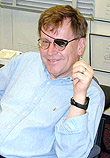-
(b.) - ?1938
Bio/Description
An American inventor and scientist, he pioneered and patented the development of GaAs high efficiency IR LEDs, used today in remote control and data link applications such as TV sets and IR LAN. This was followed by the invention and seminal work on gallium aluminum arsenide (GaAlAs) and GaAlAs/GaAs heterojunctions used in super-bright red LEDs and lasers used, for example, in CD players and short link optical fiber communications and computer networks. He also pioneered and patented the GaAlAs/GaAs heterojunction bipolar transistor used in, for example, cellular phones. Also, using GaAs/InGaAs strained, non-lattice-matched heterostructures, he pioneered the ?pseudomorphic? high electron mobility transistor (HEMT), a state-of-the-art high speed device widely used in cellular phones. Born in Washington, DC, he received a B.S. degree in Metallurgy from Massachusetts Institute of Technology (MIT) in 1960 and a PhD in Electrical Engineering from Cornell University in 1982. He worked at IBM's Thomas J. Watson Research Center where he was appointed IBM Fellow in 1985. Since 2012, he is also a Distinguished Professor of Electrical and Computer Engineering at UC Davis in Davis, California. More recently he invented, developed and published a breakthrough global scale ?green? energy storage technology in which bulk aluminum rich alloys split both fresh water and salt water into hydrogen gas on demand, thus obviating the need to store and transport hydrogen. The aluminum hydroxide reaction product is easily recycled back to aluminum via the commercial Hall electrolysis process. This feature coupled with the fact that aluminum has the highest volumetric total chemical energy density known, and the fact that aluminum has the highest volumetric total chemical energy density known, and the fact that aluminum is the third most abundant element on earth?s surface promises to make this technology a serious contender for a long haul, global scale, economically viable, alternative green energy solution. His efforts are recorded in over 350 publications in the open literature, and 85 issued U.S. patents. His accomplishments have been recognized by his election as IBM Fellow in 1985, an $80,000 IBM Corporate Award in 1992 for the invention of the GaAlAs/GaAs heterojunction, and the 2001 National Medal of Technology awarded by the President of the United States. Other recognition includes the 1980 Electronics Division Award of the Electrochemical Society (ECS), the 1984 IEEE Jack A. Morton Award, the 1985 ECS Solid State Science and Technology Award, the 1988 Heinrich Welker Gold Medal and International GaAs Symposium Award, the 1990 American Vacuum Society (AVS) Medard Welch (Founder?s) Award, its highest honor, the 1997 Eta Kappa Nu Vladimir Karapetoff Eminent Members' Award, the 1998 American Society for Engineering Education?s General Electric Senior Research Award, the 1998 Electrochemical Society?s (ECS) Edward Goodrich Acheson (Founder?s) Award, its highest honor, ECS Honorary Member (2009), an IEEE Third Millennium Medal (2000), the Federation of Materials Societies' 2002 National Materials Advancement Award, and the 2005 IEEE Jun-ichci Nishizawa Gold Medal. Honorific recognition includes his election to the National Academy of Engineering in 1989, Fellow of the American Physical Society in 1982, IEEE Fellow in 1990, ECS Fellow in 1992, and AVS Fellow in 1994. His national professional society activities include President of the ECS (1990), and President of AVS (1998).
-
Date of Birth:
1938 -
Gender:
Male -
Noted For:
Inventor of the first commercially viable heterojunction material GaAlAs for red LEDs used in automobile brake lights and traffic lights, CD and DVD players, TV remote controls and computer networks -
Category of Achievement:
-
More Info:


